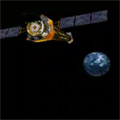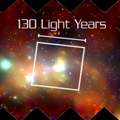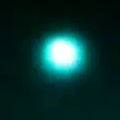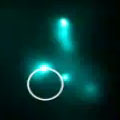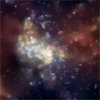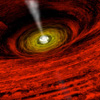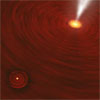CXC Home | Search | Help | Image Use Policy | Latest Images | Privacy | Accessibility | Glossary | Q&A
1. Virtual Voyage through the Milky Way: Earth to Local Group
QuicktimeMPEG Zoom out past Earth, Venus, Mercury & the Sun. Go beyond the solar system, and out of the Milky Way to our Local Group.
[Runtime: 0:56]
(NASA/CXC/A.Hobart)
QuicktimeMPEG Zoom out past Earth, Venus, Mercury & the Sun. Go beyond the solar system, and out of the Milky Way to our Local Group.
[Runtime: 0:56]
(NASA/CXC/A.Hobart)
2. Chandra's Many Views of the Center of the Milky Way
QuicktimeMPEG This sequence shows how astronomers are using Chandra to help probe the mysterious region at the center of the Milky Way. The first image is a 900- by 400-light-year mosaic in X-rays taken by Chandra. The view then zooms into a smaller region that encompasses the latest Chandra discovery of puzzling, extremely hot and diffuse emission. From there, the sequence shows two even smaller fields of view of the region surrounding the Milky Way's supermassive black hole, known as Sgr A*. The final element is an artist's conception of Sgr A* itself and its accretion disk as it undergoes a flare.
[Runtime: 0:40]
(NASA/CXC)
Related Chandra Images:
QuicktimeMPEG This sequence shows how astronomers are using Chandra to help probe the mysterious region at the center of the Milky Way. The first image is a 900- by 400-light-year mosaic in X-rays taken by Chandra. The view then zooms into a smaller region that encompasses the latest Chandra discovery of puzzling, extremely hot and diffuse emission. From there, the sequence shows two even smaller fields of view of the region surrounding the Milky Way's supermassive black hole, known as Sgr A*. The final element is an artist's conception of Sgr A* itself and its accretion disk as it undergoes a flare.
[Runtime: 0:40]
(NASA/CXC)
Related Chandra Images:
- Photo Album: Hot Gas in Galactic Center
3. Time-lapse Movie of Galactic Center X-ray Binaries
QuicktimeMPEG This sequence of 5 images is part of an ongoing Chandra program that monitors a region around the Milky Way's supermassive black hole, Sgr A*. Four bright, variable X-ray sources were discovered within 3 light years of Sgr A*. The variability is indicative of an X-ray binary system where a black hole or neutron star is pulling matter from a nearby companion star. Such a high concentration of X-ray binaries in this region is strong circumstantial evidence that a dense swarm of 10,000 or more stellar-mass black holes and neutron stars has formed around Sgr A*. The swarm likely formed as stellar-mass black holes, and to a lesser extent, neutron stars, gradually sank toward the center of the Galaxy over the course of several billion years.
[Runtime: 1:02]
(NASA/CXC/UCLA/M.Muno et al.)
Related Chandra Images:
QuicktimeMPEG This sequence of 5 images is part of an ongoing Chandra program that monitors a region around the Milky Way's supermassive black hole, Sgr A*. Four bright, variable X-ray sources were discovered within 3 light years of Sgr A*. The variability is indicative of an X-ray binary system where a black hole or neutron star is pulling matter from a nearby companion star. Such a high concentration of X-ray binaries in this region is strong circumstantial evidence that a dense swarm of 10,000 or more stellar-mass black holes and neutron stars has formed around Sgr A*. The swarm likely formed as stellar-mass black holes, and to a lesser extent, neutron stars, gradually sank toward the center of the Galaxy over the course of several billion years.
[Runtime: 1:02]
(NASA/CXC/UCLA/M.Muno et al.)
Related Chandra Images:
- Photo Album: Galactic Center X-ray Binaries
4. Sequence Showing Evidence of Black Hole Swarm in Context
QuicktimeMPEG The first image in this sequence is Chandra's 900- by 400-light year mosaic of the Milky Way's center. Next, the view zooms into a smaller region where Chandra has found some 2,000 individual X-ray sources. Finally, Chandra's view of the area immediately surrounding Sagittarius A* (Sgr A*), the Milky Way's supermassive black hole, is shown. As part of a long-term monitoring program, Chandra found several variable X-ray sources. This variability suggests these sources are in systems containing their own stellar-sized black holes.
[Runtime: 1:02]
(Galactic Center Mosaic: NASA/UMass/D.Wang et al.; Sagittarius A*: NASA/CXC/MIT/F.K.Baganoff et al.; Galactic Center X-ray Binaries: NASA/CXC/UCLA/M.Muno et al.)
Related Chandra Images:
QuicktimeMPEG The first image in this sequence is Chandra's 900- by 400-light year mosaic of the Milky Way's center. Next, the view zooms into a smaller region where Chandra has found some 2,000 individual X-ray sources. Finally, Chandra's view of the area immediately surrounding Sagittarius A* (Sgr A*), the Milky Way's supermassive black hole, is shown. As part of a long-term monitoring program, Chandra found several variable X-ray sources. This variability suggests these sources are in systems containing their own stellar-sized black holes.
[Runtime: 1:02]
(Galactic Center Mosaic: NASA/UMass/D.Wang et al.; Sagittarius A*: NASA/CXC/MIT/F.K.Baganoff et al.; Galactic Center X-ray Binaries: NASA/CXC/UCLA/M.Muno et al.)
Related Chandra Images:
- Photo Album: Galactic Center X-ray Binaries
5. Variability in Chandra Images of Light Echo
QuicktimeMPEG The first image shows Chandra data of the middle of the Milky Way, with the position of Sgr A* labeled. The view then shows how the X-ray emission in the gas clouds change in shape and brightness between the three different observations in 2002, 2004 and 2005. This behavior agrees with theoretical predictions for a light echo produced by Sgr A* and helps rule out other interpretations.
[Runtime: 0:22]
(NASA/CXC/Caltech/M.Muno et al.)
Related Chandra Images:
QuicktimeMPEG The first image shows Chandra data of the middle of the Milky Way, with the position of Sgr A* labeled. The view then shows how the X-ray emission in the gas clouds change in shape and brightness between the three different observations in 2002, 2004 and 2005. This behavior agrees with theoretical predictions for a light echo produced by Sgr A* and helps rule out other interpretations.
[Runtime: 0:22]
(NASA/CXC/Caltech/M.Muno et al.)
Related Chandra Images:
- Photo Album: Light Echo at Galactic Center
6. Images of Light Echo at Galactic Center
QuicktimeMPEG This sequence shows the location of the light echo at the Galactic Center by placing it in context with other Chandra observations of the region. The light echo is produced when X-rays from the Milky Way's giant black hole bounce off surrounding gas clouds. The light echo is found approximately 50 light years away from Sagittarius A* (or Sgr A*, for short), the supermassive black hole in the Galactic Center.
[Runtime: 0:25]
(NASA/CXC)
Related Chandra Images:
QuicktimeMPEG This sequence shows the location of the light echo at the Galactic Center by placing it in context with other Chandra observations of the region. The light echo is produced when X-rays from the Milky Way's giant black hole bounce off surrounding gas clouds. The light echo is found approximately 50 light years away from Sagittarius A* (or Sgr A*, for short), the supermassive black hole in the Galactic Center.
[Runtime: 0:25]
(NASA/CXC)
Related Chandra Images:
- Photo Album: Light Echo at Galactic Center
7. Sequence of Chandra Images of Galactic Center & Sgr A*
QuicktimeMPEG This sequence begins with a 400 by 900 light-year mosaic of several Chandra images of the central region of our Galaxy that reveals hundreds of white dwarf stars, neutron stars, and black holes bathed in an incandescent fog of multimillion-degree gas. The mosaic then zooms into a large region around the supermassive black hole at our Galaxy's center, a.k.a. Sagittarius A* or Sgr A*. Marked in this field around Sgr A* are two newly discovered large lobes of multimillion-degree gas that extend for dozens of light years on either side of the black hole. The final Chandra image in this sequence is a close-up of the location of the supermassive black hole Sgr A* and an X-ray jet. This suspected jet is 1.5 light years in length and is due to high-energy particles ejected from the vicinity of the black hole.
[Runtime: 0:22]
(Galactic Center (Survey): NASA/UMass/D.Wang et al., Sgr A* (3-color & close-up): NASA/CXC/MIT/F.K.Baganoff et al.)
Related Chandra Images:
QuicktimeMPEG This sequence begins with a 400 by 900 light-year mosaic of several Chandra images of the central region of our Galaxy that reveals hundreds of white dwarf stars, neutron stars, and black holes bathed in an incandescent fog of multimillion-degree gas. The mosaic then zooms into a large region around the supermassive black hole at our Galaxy's center, a.k.a. Sagittarius A* or Sgr A*. Marked in this field around Sgr A* are two newly discovered large lobes of multimillion-degree gas that extend for dozens of light years on either side of the black hole. The final Chandra image in this sequence is a close-up of the location of the supermassive black hole Sgr A* and an X-ray jet. This suspected jet is 1.5 light years in length and is due to high-energy particles ejected from the vicinity of the black hole.
[Runtime: 0:22]
(Galactic Center (Survey): NASA/UMass/D.Wang et al., Sgr A* (3-color & close-up): NASA/CXC/MIT/F.K.Baganoff et al.)
Related Chandra Images:
- Photo Album: Sagittarius A*
8. Black Hole Animation
QuicktimeMPEG Broadcast:
This animation illustrates the activity surrounding a black hole. While the matter that has passed the black hole's "event horizon" can't be seen, material swirling outside this threshold is accelerated to millions of degrees and radiates in X-rays. At the end of the animation, the black hole is shown shrouded in a cloud of gas and dust, obscuring it from most angles at wavelengths other than the X-rays picked up by the Chandra X-ray Observatory.
[Runtime: 0:27]
View Stills
(NASA/CXC/A.Hobart)
QuicktimeMPEG Broadcast:
- QuickTime movie (uncompressed)
- D1 (0.9 pixel aspect ratio)
- 720x486
- 29.97 fps
- file size = (460.6 MB)
This animation illustrates the activity surrounding a black hole. While the matter that has passed the black hole's "event horizon" can't be seen, material swirling outside this threshold is accelerated to millions of degrees and radiates in X-rays. At the end of the animation, the black hole is shown shrouded in a cloud of gas and dust, obscuring it from most angles at wavelengths other than the X-rays picked up by the Chandra X-ray Observatory.
[Runtime: 0:27]
View Stills
(NASA/CXC/A.Hobart)
9. Scenario Dismissed by Chandra Results
QuicktimeMPEG Broadcast:
This sequence of artist's renderings shows the scenario ruled out by the latest Chandra results. In this model, a cluster with both low (red) and high (blue) mass stars is drawn toward the black hole. Eventually, the strong gravitational forces would rip the cluster apart, sending its constituent stars into orbit around the black hole.
[Runtime: 0:10]
View Stills
(Illustrations: NASA/CXC/M.Weiss)
Related Chandra Images:
QuicktimeMPEG Broadcast:
- QuickTime movie (uncompressed)
- D1 (0.9 pixel aspect ratio)
- 720x486
- 29.97 fps
- file size = (32.9 MB)
This sequence of artist's renderings shows the scenario ruled out by the latest Chandra results. In this model, a cluster with both low (red) and high (blue) mass stars is drawn toward the black hole. Eventually, the strong gravitational forces would rip the cluster apart, sending its constituent stars into orbit around the black hole.
[Runtime: 0:10]
View Stills
(Illustrations: NASA/CXC/M.Weiss)
Related Chandra Images:
- Photo Album: Sagittarius A*
10. Animation of Stars Forming Around Black Hole
QuicktimeMPEG Broadcast:
This animation shows a disk of red and yellow gas around a supermassive black hole. As the view pulls back, the formation of stars in the outer regions of the disk is seen. These massive stars form when the gas becomes unstable, despite the black hole's enormous gravitational influence, and collapses inwards.
[Runtime: 0:23]
View Stills
(NASA/CXC/A.Hobart)
Related Chandra Images:
QuicktimeMPEG Broadcast:
- QuickTime movie (uncompressed)
- D1 (0.9 pixel aspect ratio)
- 720x486
- 29.97 fps
- file size = (493.7 MB)
This animation shows a disk of red and yellow gas around a supermassive black hole. As the view pulls back, the formation of stars in the outer regions of the disk is seen. These massive stars form when the gas becomes unstable, despite the black hole's enormous gravitational influence, and collapses inwards.
[Runtime: 0:23]
View Stills
(NASA/CXC/A.Hobart)
Related Chandra Images:
- Photo Album: Sagittarius A*


